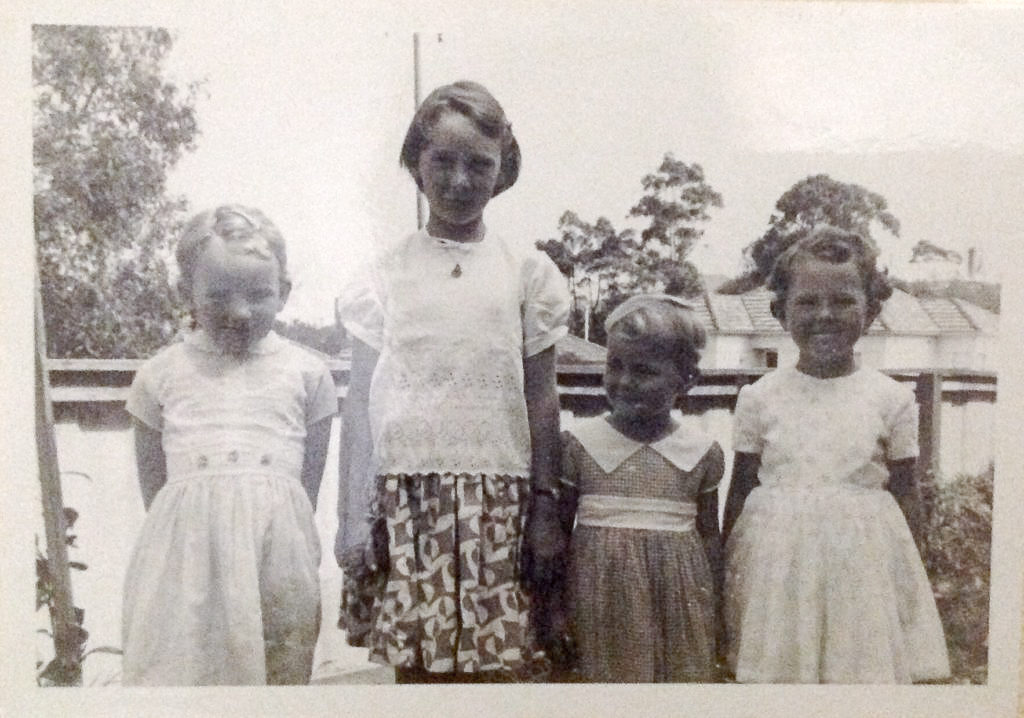I grew up in Windsor in the 1960s. When I was about 9 or 10, it was not unusual for our mums to give us 2/- (20c) and tell us to go out for the day. There was nothing my friends and I liked more on a weekend than to catch the tram to the Centenary Pool, then follow it up with a visit to the Old Museum. There were usually 5 or 6 of us (no adults) and we would spend hours exploring the nooks and crannies of the old Gothic building in Gregory Terrace or playing on the Mephisto Tank that stood like a guardian at the main entrance. One day we decided to play a game of hide and seek on the first floor where all the insect cabinets were. I always found this the most interesting part of the Museum, because you could look down on the T Rex skeleton or Bert Hinkler’s Avian from above. Anyway, we were playing hide and seek when my friend said he spotted one of the girls in our group hiding on the stairs leading up to the next floor. However, when we called out to her, she took off up the stairs. To our surprise, when we turned around our friend was behind us and she said that she had spotted the other girl too. So we went to see where the girl on the stairs had gone, but when we got there we found that the stair led to a door that was firmly locked. I had not thought about that much in the past 50 years until recently when I was talking to Alannah Ruth, the present curator of the Old Museum Building, who told me an eerily familiar story about the Ghost of the young girl who lives on the stair!
Category: Parts of the place (Page 1 of 3)
I started work in the Old Museum in the entomology section in February 1982 and so had four years there until we moved in 1986.
I had visited as a young kid and always wanted the keys to the insect display cases. So I achieved one of my childhood ambitions. Many of these insect displays had been done by Henry Hacker in the early twentieth century and had not changed. There were some modern panels in the old cases but not many. The old displays had canvas covers to exclude the light, which you lifted to look at them. These were later removed. The cases were beautiful cedar, with turned legs and angled panes of old glass on each viewing side. The displays were on angled, paper-covered pine boards with old, specially printed labels on grey card (done by the Government Printer) and the insect specimens were pinned directly into the hoop pine through the white paper. There were many interesting life histories and rare specimens but time had faded them. When the move came we kept the specimens but could not store the whole displays.
Some fish were displayed in similar cedar cases. The fish were hand-painted plaster casts. I remember being on the display floor with other staff, when a nearby young girl suddenly burst into giggles. The education officer calmly said “Ah! She’s found it”. There was a biro nib sticking out of the mouth of a parrot fish.
By that time the Queensland Art Gallery had moved out and QM staff had filled every nook and cranny of the buildings and out buildings. Admin was in a demountable, as was conservation, while history and technology was in some of the big sheds.
Art and display staff were mainly in the old concert hall where the art gallery had been. Melba had sung there in the past and it was where the city hall organ was originally installed. We could go up the grand stairway to where archaeology and ethnology collections and staff were housed. Sometimes I even went up into the towers. Now all this is deemed unsafe and off limits.
Curatorial staff were mainly in the basement, entered round the back. There was one toilet for each gender, way into the bowels of the building near the earth basement.
The wonderful library had spilled out of its main room down the long, high-ceilinged corridors and I passed old books like The Pears of New York and early hand-coloured insect publications on my way to my desk.
There was no air conditioning and the west wall heated up like an oven in summer. The concrete floors were cold in winter too. The entomology room at the end of that long book-lined corridor had staff crammed in among the lovely old cabinets with a strong smell of naphthalene. There was a big white, arched, drop-sash window at the end of the room away from me and my boss.
In spring the gardens were a delight, with wonderful hedges of jasmine, beds of Iceland poppies, pansies, stocks and roses. We used to take our morning tea out to enjoy there on nice days. During the Ekka the noise of people on the rides was a constant background. We felt privileged with free parking in the middle of it all.
The switch board was a plug-in manual type and there were constant PA announcements when the receptionist couldn’t find someone at their desk. There was a big typing pool of women typists, as there were no computers and curators spent a lot of time writing letters, long hand, which were then typed, checked, signed and the pink carbon copy filed.
The staff was relatively small and I often ate lunch with the then director and other senior staff but that was always inside, at a big old pine table. As a whole, the staff were an amazing bunch of talented, friendly people, with the most incredible range of knowledge and skills (as is still the case). There were conflicts but generally it was a happy place and the amount of work done was prodigious. Filling the whole new museum with displays was a massive job. I remember volunteering to help with whale construction one weekend. I think I helped glue on cast barnacles.
One Friday afternoon, 18 January 1985, there was a huge hail storm. It was after 4.00 pm and many staff had gone home. I remember grabbing old books off bookshelves in the late Patricia Mather’s office, as water started to pour down the walls. I don’t recall any damage to the precious books but it was a near-run thing. Other staff were trapped higher up in the building, as about 360 panes of glass were smashed by the hail and shards of glass flew everywhere. Some shards like daggers were later found embedded vertically in the old pine stairs. When I went to my car the back windscreen was smashed, there was extensive panel damage and a foot of water and ice round the pedals.
A special highlight was the day the machinery restoration team fired up the Garrett traction engine for the first time. The brightly painted engine, sounding its whistle and trundling round the bitumen drives was unforgettable, as was the pleased-as-punch face of the chief restorer.
One time, to the surprise of all, a noisy pitta turned up in the museum garden and took up residence for quite a while.
The move to the Cultural Centre was a huge job. My fellow insect technician, the late Gudrun Sarnes, and I moved 1,000 drawers of insects in the back of a Toyota Hi-Ace van, driving very slowly on many trips. Not a specimen was damaged.
I went on my first trip to Europe in 1986 but returned just in time for the final staff party at the old building. It was a lovely gathering with past and present staff all enjoying the side verandah. I still miss things about the old place.
I would have been 10 or 11 when I came the first time. I came a couple of times on school excursions with the Ascot State School. I was born in ’52, so was at school in the late ’50s and ’60s. We would have come in by bus—the bus route went along Anthony Street. At the bottom you could get a tram from Oriel Park.
I remember the size and grandeur of the building, and the large rooms, and the quiet. When we came it was really hot, and inside was really hot, even though the ceilings were high. I remember the display cases, and not to lean on them! It was the only place you could see a dinosaur.
I used to swim at Centenary Pool and the Spring Hill Baths, and see the beautiful old building. I would see it with its windows broken—that made me sad. I think buildings need to be loved and lived in and filled with people.
I called in today as I’m here with my husband, who’s the dairy rep on the RNA council.
A note from the editor: Mary Jensen told this story to Margie Barram at the Australian Garden History Society display at the Ekka.
My daughter Pam, who’s now 54 and lives in Melbourne, came here often with her father, and sometimes we’d all come together. I recall the big display cabinet with the African lion—Pam must have only been five or so, because the lion was bigger than her. It had presence, even though it was a bit moth eaten.
There were these rows of display cabinets, and signs “Don’t lean on the glass”. It is altogether different now—all hands on. But then it was stand back and observe. We’d talk about what we were seeing, and learn about the exhibits. Now it seems the parents are all on their phones while the children play—not something done together.
A note from the editor: Myra Collom told this story to Margie Barram at the Australian Garden History Society display at the Ekka.
I’m from a Brisbane family and we visited throughout the 1970s. The glass cases stand out in my memory, and also the garden. I’m here with the Ekka—it’s great the gardens survived and weren’t hacked about with all the different uses since the museum left.
A note from the editor: Elizabeth Gillespie told this story to Margie Barram at the Australian Garden History Society display at the Ekka.
I love writing stories, and found it a little hard to pick just one that relates to the museum.
We were always visitors to Brisbane. Each year in the humid school holidays at Xmas we would drive the long dusty highway to visit Gran.
My grandmother lived in a cottage in East Brisbane, and for some reason she would take most of us (four girls in our family and four boy cousins) to the museum for the day. Like going to the pictures, Gran would bring a large bottle of cordial, a packet of bikkies and some sandwiches.
As a small girl it always seemed such a journey—I guess there was the bus from East Brisbane to the Valley, and then another bus up the hill to the door, or maybe it was still a tram.
There were two main memories, the first was being lost in the cavernous halls full of mystery, and the second was lunch out in the elegant gardens. We had nothing like this building in Canberra.
When I returned to Brisbane with my own three children, realising that the museum had moved, I took them all eagerly to South Bank. They didn’t have any expectation, but I apologised to them on the way in. I had built this trip up to be an adventure, a museum of natural history, a place of caverns, stair wells and being lost. It was too clean, too organised. We have become used to it now, but I wish they had the opportunity to know the old museum.
(the photo was from the time, but not from the museum)

My earliest childhood memories are so very special to me and all my siblings. We grew up in the early 1950s around the Lota–Wynnum area. My dad built our house at Lota when there were only a very few people in the area. We first lived at Allister Street Lota in the small two-bedroom house that is still standing to this day. Each fortnight my dad would add a little more to the house, as money was hard to come by and building materials were very dear.
We were a poor family, but very rich in love. My mum had a large family—eventually there were 12 of us kids, three boys and nine girls, but the other two boys were the babies of the family, so our brother was third in line after two sisters and then the rest of us girls down to the twin boys, so he had a lot to contend with. We were always happy and got along just fine. Our outings were very special to us because of where we were taken and it was usually on a Sunday. A lovely train ride from Lota, or Wynnum where we lived later, to the beautiful palace that was ours. That is what we had in our hearts and minds: that the beautiful museum building in the Valley was ours alone.
What fantasies we created. It was our palace—running from floor to floor lifting the brown covers that were over a lot of the glass topped display cabinets to reveal another fascinating specimen—the wonderful skeletons and exotic collections from faraway lands—the magnificent lions and tigers at the front desk—our minds went wild with imagination—then the big lung fish out on the beautiful verandah. This was our special place—we each imagined that parts of that glorious building was our “home” and we would go and visit our brother and sisters in their part of this “palace”.
Mum would always take a packed lunch for us all and then we would sit in the beautiful gardens and imagine that we were very rich indeed to have such a wonderful home. The day would never end without the obligatory climbing all over the “Mephisto,” the old war tank at the entrance. We loved that old building, it was a complete part of our childhood. Many of us married and had children and took them to visit this special place that was so dear to us as well. Until Brisbane lost its identity and some of its history, a sad day to see the museum being moved. We have visited the new one in South Bank a few times and I am so sorry to say it has no charm. It’s clinical and uninteresting. We lost a wonderful tourist destination and a beautiful piece of history.
Please don’t ever demolish this building. It is well loved and part of Brisbane’s history. Thank you for reading.
I’m from Ashgrove—well really Oakleigh—but its not a suburb anymore. It’s near the army base at Enoggera. I went to the Oakleigh State School in the late ’40s—over a thousand kids there then. I had an uncle who was a Queensland senator.
I remember the Mephisto from a visit in the late 1950s but really the old museum building was a place I was always going past, and every so often I’d have a closer look. I recall the dusty corridors upstairs and the display cases—full of rocks!
What took me past? I played hockey for a while—that was at Victoria Park. So I’d catch the tram to it and walk back to the museum to catch the tram home. I played school football in Ballymore Park—we’d all ride our bikes there, play, and ride back. Or those who took the tram would come back to the museum to catch their tram home. In ’59—I was fourteen—I’d always be going to the Centenary Pool. It was the place to be. I’d ride my bike over. Your bike was like part of your body. It was freedom.
I was always going past, and sometimes I’d take a closer look.
Notes from the editor: Noel Milliner told this story to Margie Barram at the Australian Garden History Society display at the Ekka. The uncle Noel mentions in the story was Senator Bertie Milliner, whose sudden death in 1975 precipitated the contentious appointment of Albert Field to the senate and the constitutional crisis that followed. Noel’s nephew Glen Milliner served as a member of the Queensland parliament.
I’ve always loved the architecture of the old building. I recall the hanging dinosaur and the exhibits—snakes and lizards in jars—and the skeletons.
I was visiting in the 1970s. I lived out west—Roma—and each year we’d come to the Ekka for a few days, and then to grandma’s at Redcliffe for a few days. I’d see the beautiful old building on the corner. It was terrible to see it neglected—there were ten years of disrepair—I remember it had broken windows. It picked up when the orchestra came.
A note from the editor: Richard Kennedy told this story to Margie Barram at the Australian Garden History Society display at the Ekka.
I came to an evening concert, given by the youth orchestra, with my husband and eldest son. My son instigated the outing. He was very into music, particularly brass bands. He plays cornet and trumpet, and is interested in sax. He’s in the UK at the moment and just joined a local brass band. My husband came, not just for the concert, but because he’s into organs, and was very impressed with the organ here. The original one went to City Hall, and this is the “new” one. He’s also an architect (now retired) so was really in his element in the old building. This concert would have taken place in the 2000s, and in winter—I remember we wore our coats to it.
A note from the editor: Sheena DeJager Miles told this story to Margie Barram at the Australian Garden History Society display at the Ekka.


Recent Comments